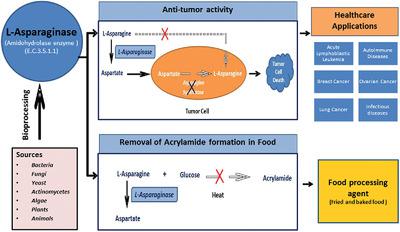当前位置:
X-MOL 学术
›
Biotechnol. Appl. Bioc.
›
论文详情
Our official English website, www.x-mol.net, welcomes your
feedback! (Note: you will need to create a separate account there.)
A comprehensive review on microbial l-asparaginase: Bioprocessing, characterization, and industrial applications.
Biotechnology and Applied Biochemistry ( IF 3.2 ) Pub Date : 2020-01-18 , DOI: 10.1002/bab.1888 Subhash Chand 1, 2 , Richi V Mahajan 1 , Jai Prakash Prasad 1 , Debendra K Sahoo 3 , Kanti Nandan Mihooliya 3 , Mahesh S Dhar 2 , Girish Sharma 2, 4
Biotechnology and Applied Biochemistry ( IF 3.2 ) Pub Date : 2020-01-18 , DOI: 10.1002/bab.1888 Subhash Chand 1, 2 , Richi V Mahajan 1 , Jai Prakash Prasad 1 , Debendra K Sahoo 3 , Kanti Nandan Mihooliya 3 , Mahesh S Dhar 2 , Girish Sharma 2, 4
Affiliation

|
l‐Asparaginase (E.C.3.5.1.1.) is a vital enzyme that hydrolyzes l‐asparagine to l‐aspartic acid and ammonia. This property of l‐asparaginase inhibits the protein synthesis in cancer cells, making l‐asparaginase a mainstay of pediatric chemotherapy practices to treat acute lymphoblastic leukemia (ALL) patients. l‐Asparaginase is also recognized as one of the important food processing agent. The removal of asparagine by l‐asparaginase leads to the reduction of acrylamide formation in fried food items. l‐Asparaginase is produced by various organisms including animals, plants, and microorganisms, however, only microorganisms that produce a substantial amount of this enzyme are of commercial significance. The commercial l‐asparaginase for healthcare applications is chiefly derived from Escherichia coli and Erwinia chrysanthemi. A high rate of hypersensitivity and adverse reactions limits the long‐term clinical use of l‐asparaginase. Present review provides thorough information on microbial l‐asparaginase bioprocess optimization including submerged fermentation and solid‐state fermentation for l‐asparaginase production, downstream purification, its characterization, and issues related to the clinical application including toxicity and hypersensitivity. Here, we have highlighted the bioprocess techniques that can produce improved and economically viable yields of l‐asparaginase from promising microbial sources in the current scenario where there is an urgent need for alternate l‐asparaginase with less adverse effects.
中文翻译:

微生物l-天冬酰胺酶的全面综述:生物加工,表征和工业应用。
l-天冬酰胺酶(EC3.5.1.1。)是一种重要的酶,可将l-天冬酰胺水解为l-天冬氨酸和氨水。l-天冬酰胺酶的这种特性抑制了癌细胞中的蛋白质合成,使l-天冬酰胺酶成为治疗急性淋巴细胞白血病(ALL)患者的儿科化学疗法的主要手段。l-天冬酰胺酶也被认为是重要的食品加工剂之一。l-天冬酰胺酶去除天冬酰胺可减少油炸食品中丙烯酰胺的形成。升-天冬酰胺酶是由包括动物,植物和微生物在内的各种生物产生的,但是,只有产生大量这种酶的微生物才具有商业意义。用于医疗保健用途的商业性l-天冬酰胺酶主要来源于大肠杆菌和菊花欧文氏菌。超敏反应和不良反应的高发生率限制了l-天冬酰胺酶的长期临床应用。本次审查中提供了对微生物的详尽资料升-asparaginase生物过程优化,包括深层发酵和固态发酵升-天冬酰胺酶的生产,下游纯化,其表征以及与临床应用相关的问题,包括毒性和超敏反应。在这里,我们重点介绍了生物工艺技术,在当前迫切需要副作用较少的替代性l-天冬酰胺酶的情况下,可以从有前途的微生物来源中提高l-天冬酰胺酶的产量并在经济上可行。
更新日期:2020-01-18
中文翻译:

微生物l-天冬酰胺酶的全面综述:生物加工,表征和工业应用。
l-天冬酰胺酶(EC3.5.1.1。)是一种重要的酶,可将l-天冬酰胺水解为l-天冬氨酸和氨水。l-天冬酰胺酶的这种特性抑制了癌细胞中的蛋白质合成,使l-天冬酰胺酶成为治疗急性淋巴细胞白血病(ALL)患者的儿科化学疗法的主要手段。l-天冬酰胺酶也被认为是重要的食品加工剂之一。l-天冬酰胺酶去除天冬酰胺可减少油炸食品中丙烯酰胺的形成。升-天冬酰胺酶是由包括动物,植物和微生物在内的各种生物产生的,但是,只有产生大量这种酶的微生物才具有商业意义。用于医疗保健用途的商业性l-天冬酰胺酶主要来源于大肠杆菌和菊花欧文氏菌。超敏反应和不良反应的高发生率限制了l-天冬酰胺酶的长期临床应用。本次审查中提供了对微生物的详尽资料升-asparaginase生物过程优化,包括深层发酵和固态发酵升-天冬酰胺酶的生产,下游纯化,其表征以及与临床应用相关的问题,包括毒性和超敏反应。在这里,我们重点介绍了生物工艺技术,在当前迫切需要副作用较少的替代性l-天冬酰胺酶的情况下,可以从有前途的微生物来源中提高l-天冬酰胺酶的产量并在经济上可行。











































 京公网安备 11010802027423号
京公网安备 11010802027423号